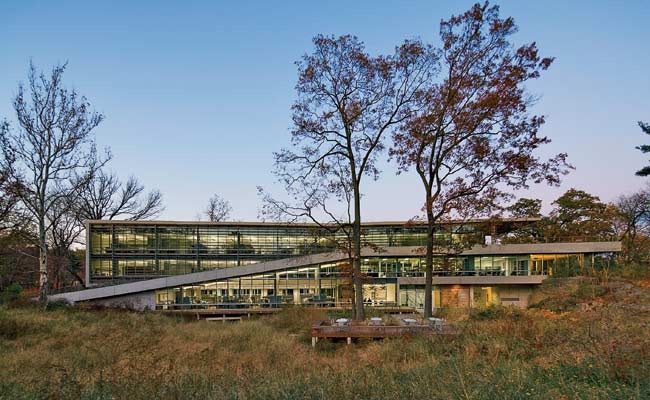Wildlife Conservation Center
Center for Global Conservation
C. V. Starr Science Campus Bronx Zoo 2300 Southern Blvd.
Architect: FxFowle Architects
When the Wildlife Conservation Center (WCC) wanted to bring together staff working in various buildings across its Bronx Zoo property, it turned to FxFowle Architects—the firm that successfully renovated its Lion House in 2008. Built with public-private financing, the resulting Center for Global Conservation (CGC)—designed for the WCC’s C.V. Starr Science Campus at the Zoo, is a “green” three-story 40,000 square foot office building with Gold LEED Certification.
The WCC operates wildlife parks and over 500 conservation centers around the world. The CGC is now its command center and international headquarters. The proximity of over 140 conservators, researchers and other WCC staff, now based in the CGC, enhances their working relationships and collaborations. The building’s design and extensive use of glass creates immediacy between the inside and surrounding grounds. Just looking out the window, one might see wild turkeys, Inca terms, muskrats or goldfinches. The intensive (vegetation covered) “green” roof system slopes to the meadow below along a walking path pleasantly lined with native grasses, shrubs and wildflowers.
The CGC is set between two rock outcroppings in a clearing on the northern edge of the WCC’s property. It enjoys an east-west orientation, favorable to natural light. The building’s inflected (bent) rectangular shape was intentionally designed to conserve nearby specimen (unique) trees. Other trees cleared from the site were milled and repurposed as building trim. Red sandstone panels saved from the original Lion House (1903) line a wall in the main conference room. Office and meeting spaces are on the building’s perimeter, while support areas are positioned at the off-center core. The CGC is in a migratory path and ornithologists encouraged the use of Ornilux glass windows which appear opaque to birds. This safety measure prevents clear glass collisions that would otherwise weaken birds, making them vulnerable to predators.
The CGC’s design features reduced energy consumption by some 48% compared with similar buildings. A microturbine installation at the building’s western edge generates all of the CGC’s electricity and heating needs. Double-glazed, low E-curtain use minimizes both thermal loss and the intake of excess solar heat. In 2009, the CGC’s architects were recognized with a Design Award by the Public Design Commission of the City of New York. In 2010 the CGC earned them an Excellence in Design Award, in the institutional category, from the trade magazine Environmental Design & Construction (ED+C).
Janet Butler Munch
